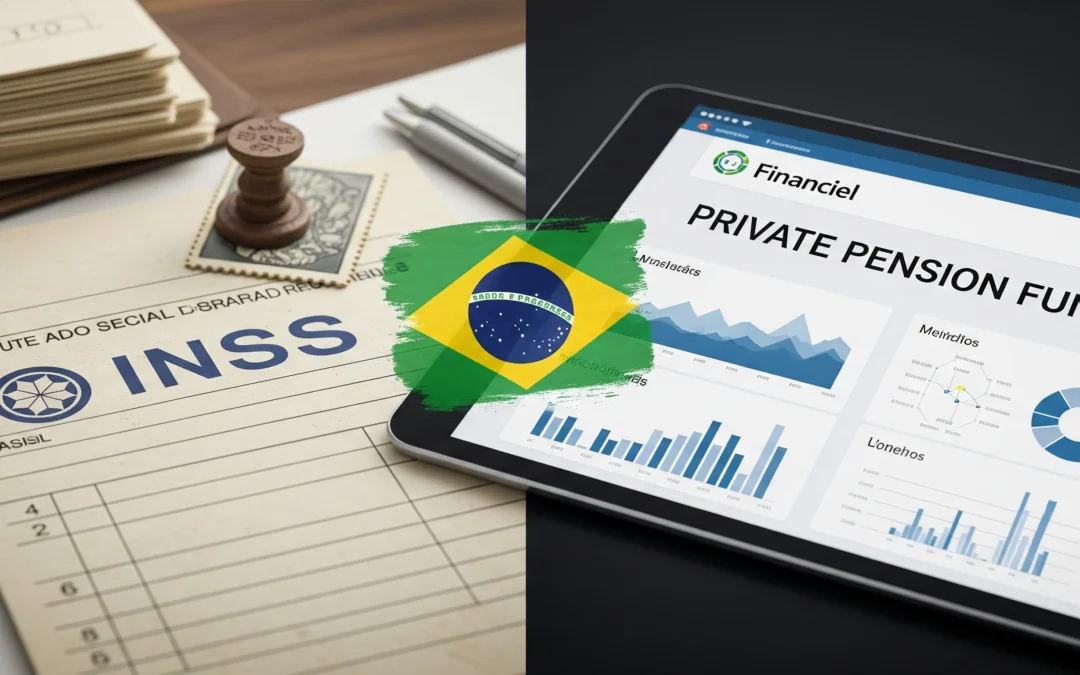Brazil’s pension world has changed a lot lately, and if you’re thinking about your future (yep, even at 15!), it’s smart to get it. The INSS and private pension funds might sound boring, but they’re basically your future money superheroes. Knowing how they work now can save you headaches later—like avoiding that “wait, I can’t retire?” panic. Stick with me, and I’ll break it down so you can plan like a pro.
Understanding Brazil’s Dual Pension System
Alright, wanna get Brazil’s pension system without falling asleep? Here’s the deal: the government gives you a basic safety net (INSS), like your grandma making you save a bit from your first paycheck—boring but lifesaving.
Then there’s the fun part: private pensions. Think of it as building your own epic treehouse for the future. Start small now, and by the time you’re older, you could be chilling, traveling, or just living comfortably—way beyond “getting by.”
It seems tricky because the rules keep changing—retirement age, contributions, all that math. But the main tip? Watch the updates, and if you can, start your private savings early. Your future self will high-five you for it.
The INSS: Brazil’s Public Pension Foundation
Current contribution structure and rates
Alright, picture the INSS as Brazil’s safety net for your future—you pay in now, and it has your back later with retirement, disability, and survivor benefits. Starting January 1, 2025, the rules got an update, so here’s the scoop:
If you’re an employee, your contribution depends on what you earn:
- Low earners start at 7.5%
- High earners can go up to 14%
Employers also chip in a lot—about 20% of your salary, sometimes 22.5% depending on the industry. Think of it like your parents not only giving you an allowance but also putting extra in a piggy bank for your future.
Benefit calculations and retirement requirements
After the 2019 pension reform, things got a bit trickier. Here’s the deal for private-sector workers:
- Men retire at 65, women at 60 (in cities), with at least 15 years of contributions
- Or, if you grind for years: men can retire after 35 years of contributions, women after 30—age doesn’t always matter here
- The pension? It starts at 60% of your salary, then adds 2% for every extra year of contributions, up to 100%
INSS contribution limits and maximum benefits
Here’s the kicker: the INSS has a cap. In 2024, it’s 7,786.02 BRL per month. If you earn more than that, your extra cash doesn’t make your INSS pension bigger—so higher earners really need private pension plans to get that extra comfort.
Private Pension Funds: Bridging the Retirement Gap
The role of complementary pension schemes
Think of private pension funds like a power-up for your INSS safety net. Officially called the Complementary Pension Regime (Regime de Previdência Complementar, or RPC), they’re designed to make sure you don’t just scrape by when you retire.
Why does it matter? Well, public sector workers hitting retirement get capped at the INSS max—back in 2024, that was R$7,507.49. Want to live a bit fancier or travel the world in your golden years? That’s where private pensions step in. They’re like building your own upgrade on top of the standard INSS gear.
Market scale and economic impact
Here’s a fun fact: Brazil’s private pension funds are huge—so big they manage about 11% of the country’s GDP in 2024. That’s not just retirement money; it’s money that helps the economy grow, funds investments, and basically powers the country’s financial engine.
Types of private pension plans
- Defined benefit plans (DB): Old-school plans that promise a fixed pension based on your salary and years worked.
- Defined contribution plans (DC): Your pension depends on what you put in and how your investments perform.
- Variable contribution plans: A mix of the two—some guarantees plus flexibility. Kind of like having the best of both worlds.
Recent regulatory changes
The government has been tweaking the rules too. Super-rich families used to have special private funds with crazy benefits, but now there’s a BRL 5 million cap to make taxes fairer. Basically, the system is always adjusting to keep the game balanced.
Navigating Both Systems: Strategic Considerations
Income replacement strategy
Okay, imagine retirement as leveling up in a video game. The INSS is your starting gear—solid, but not enough for the epic stuff. Private pensions are the upgrades that let you keep living your best life. Here’s the cheat sheet:
- Lower-income workers: INSS might be enough to cover basics. Your mission? Max out your contribution years and maybe toss in extra if you can.
- Middle-income workers: INSS gives you a safety net, but not enough for your dream retirement. Time to power up with private pension contributions.
- Higher-income workers: Private pensions are essential, and you might need multiple “characters” (pension plans) to keep your lifestyle on point.
Tax implications and optimization
Both systems have tax rules, so knowing them is like finding hidden bonuses in a game. Use them right, and you keep more coins for later.
- INSS tax treatment: Your contributions come straight out of your gross salary, and taxes hit your benefits when you cash them in. Simple, but limited perks.
- Private pension tax advantages: Some contributions can lower your taxable income, growth inside the fund isn’t taxed until withdrawal.
Investment considerations for private pensions
Private pensions aren’t just savings—they’re like choosing your adventure style:
- Conservative options: Government bonds and fixed income. Safe, like sticking to the beginner level, but slower growth. Perfect if retirement is near.
- Moderate risk options: A mix of stocks and bonds. Balanced, like a mid-game strategy—risk vs reward. Great for mid-aged players.
- Aggressive growth options: Mostly stocks. High risk, high reward. Perfect if you’re young, patient, and ready for long-term wins.
Maximizing Your Retirement Benefits
Contribution timing and strategies
Even tiny contributions to private pensions in your twenties can snowball into something massive thanks to compound interest—think of it like planting a money tree that keeps growing while you’re busy living your life.
- Maximize employer contributions: If your job offers matching contributions, don’t sleep on it! Not putting in enough to get the full match is like leaving free coins on the table.
- Consider voluntary INSS contributions: If your income is irregular or you just want a bigger safety net, you can top up your INSS contributions.
Regular review and adjustment
Retirement planning isn’t “set it and forget it.” You need to check in regularly, especially if:
- Your income or money situation changes
- The government tweaks INSS or private pension rules
- Your investments are doing weird stuff in the market
- Life throws curveballs—marriage, kids, or new careers
Professional guidance
Brazil’s pension system can feel like a crazy, complicated game. A qualified financial advisor is like having a pro gamer guide you:
- Figuring out the best contribution levels
- Picking investments that actually make sense for you
- Staying on top of rule changes
- Coordinating your INSS and private pensions for maximum benefits
Planning for the Future
Demographic trends and system sustainability
Here’s the reality check: Brazil, like lots of countries, is seeing an aging population and fewer babies being born. That means the INSS system is under pressure, but it also makes private pensions more important than ever. Think of it like a crowded rollercoaster—fewer people joining in now, so the ride for future retirees needs careful planning. If you’re just starting your work journey, the rules and conditions you’ll face when you retire might look totally different from today.
- Read also: Mexico: Understanding AFOREs and the SAR System
- Read also: Argentina: A Guide to the ANSES Pension System
Technology and access improvements
The good news? Technology is making this whole retirement thing way easier. Online platforms let you:
- Track your INSS contributions and see what your future benefits might be
- Keep an eye on your private pension accounts
- Learn about retirement planning without boring textbooks
- Compare pension funds like shopping for the best gaming gear
Conclusion
Navigating Brazil’s pension world is like leveling up in a long game—you’ve got the INSS as your starter gear and private pensions as the epic upgrades. The INSS keeps you safe, but private pensions let you actually live your golden years like a boss.
The keys? Start early, know how public and private systems work together, keep up with rule changes, and get advice when you need it. Think of it like checking game patches and leveling guides—staying informed makes all the difference.

